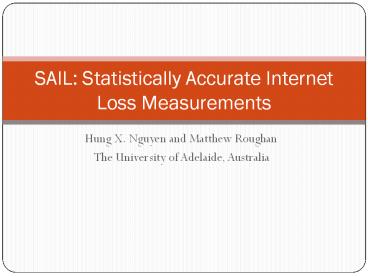Hung X. Nguyen and Matthew Roughan - PowerPoint PPT Presentation
Title:
Hung X. Nguyen and Matthew Roughan
Description:
SAIL: Statistically Accurate Internet Loss Measurements Hung X. Nguyen and Matthew Roughan The University of Adelaide, Australia Internet Loss Measurement Network ... – PowerPoint PPT presentation
Number of Views:97
Avg rating:3.0/5.0
Title: Hung X. Nguyen and Matthew Roughan
1
SAIL Statistically Accurate Internet Loss
Measurements
- Hung X. Nguyen and Matthew Roughan
- The University of Adelaide, Australia
2
Internet Loss Measurement
- Network operators continuously perform loss
measurements - SLA contracts
- We need to know that the problem exists before
we can fix it - Active probing inject probe packets into the
network - Many IETF standards (RFC3357, RFC2330) and
commercial products (Cisco IOS IP SLA, Agilent's
Firehunter PRO) - Poisson Probes PASTA (Poisson Arrivals See
Time Average) - N samples, typical loss metrics
- loss rate of successes/N (RFC2330)
- lengths of loss and good runs (RFC3357)
good run
loss run
Source
Destination
Probes
3
Accuracy of Loss Measurements
Loss rate Loss run length mean (std)(second)
Web-like traffic
True values 0.93 0.136 (0.009)
Poisson probes (10Hz) 0.14 0(0)
Poisson probes (20Hz) 0.12 0.022 (0.001)
TCP traffic
True values 2.65 0.136 (0.009)
Poisson probes (10Hz) 0.05 0 (0)
Poisson probes (20Hz) 0.02 0(0)
ATT network, Ciavattone et al. 2003
Testbed at Wisconsin, Sommer et al. 2008
4
Errors in loss estimates
- PASTA is an asymptotic result (N 8)
- We need to compute the statistical errors of the
estimations (e.g., variance) - Loss rate ,
- Ii is the indicator function of probe ith
- Variance
, - R(tij) is the auto-covariance function of probes
ith and jth - Probes miss ON/OFF intervals
5
The auto-covariance function R(tij)
- Empirical computation
- R(tij) can be computed directly from the samples
- Assume independent samples (commonly used)
- But losses are correlated, a model for the
underlying loss process that captures sample
correlation - Alternating Renewal ON/OFF model Ai,Bi are
independent - Ai,Bi are Gamma distributed with parameters
(k0,T0)and (k1,T1)
6
Inferring model parameters
- Missing intervals problem
- Many short ON (or OFF) periods are not observed
- loss run lengths and good run lengths observed by
the probes are much larger than the real values - Hidden Semi-Markov Model (HSMM) to the rescue
7
Forward and Backward Algorithm
- Estimating (k0,T0)and (k1,T1) is a statistical
inference with missing data problem - Direct Maximum Likelihood Estimation is costly
- O(2U), U is the number of un-observed intervals
- Forward and Backward algorithm to speed up
- Exploiting the renewal properties
- Expectation-Maximization algorithm
- O(2T2), T is the number of intervals
- Knowing (k0,T0)and (k1,T1) , compute R(tij) using
inverse Laplace transform - Numerical inversion
- Simulation
8
SAIL
- Input
- Probe sending times t1, , tN
- Probe outcomes I1, , IN
- The length of the discrete time interval ?T
- Algorithm
- Apply the forward and backward algorithm to
compute (k0,T0) and (k1,T1) - Apply the inverse Laplace transform to find R(t)
- Compute the loss rate and its variance
- Output
- The loss rate and its confidence intervals
- The parameters (k0,T0) and (k1,T1) of the loss
process
9
Simulation
- Alternating ON/OFF renewal process with Gamma
intervals, 4 parameters Ai(k0,T0) and Bi
(k1,T1) - Poisson probes with rate ?
SAIL works when the model assumptions are correct
10
Simulation- ON/OFF duration
SAIL can correct the missing intervals problem
and is needed.
11
Simulation- Loss rate
SAIL is more accurate than other methods in
computing the statistical errors
12
Measurements - Datasets
- UA-EPFL 1 host at the University of Adelaide and
1 at EPFL, Switzerland - PlanetLab randomly selected source and
destination pairs - Poisson probes with small packet size (40 bytes)
- 1 hour traces, in each trace the probing rate is
a constant - Stationarity tests using heuristics (no
big/sudden jump and no gradual trend in the
moving average loss rate)
UA-EPFL PlanetLab
Hours 100 5246
stationary traces 10 1090
13
Renewal Properties
Autocorrelation function test to verify renewal
properties
14
Cross validation
Traces are divided randomly into two sub-segments
of equal length. Each sub-segments can be viewed
as Poisson samples with rate ?/2.
15
Empirical Variances
SAIL
Empirical
It is important to use a correct method to
compute the variance (e.g., SAIL)
16
Shape Parameters of the Loss Processes
ON
OFF
The OFF periods appear to be exponentially
distributed
17
Errors in Estimating ON/OFF durations
Errors can be quite large because of the missing
(short) ON/OFF intervals problem
18
Prediction
SAIL can be used to estimate future loss rate
19
How Many Probes
Increasing sampling rate only yields small
improvements in the variance
20
Summary
- SAIL accurately computes errors in loss
estimates - Better than any existing alternative
- Future work
- Faster inference algorithm
- Non-parametric models for the loss process
- On-line
- Make SAIL available to network operators/users
- Code is publicly available, please try
- Thanks!































